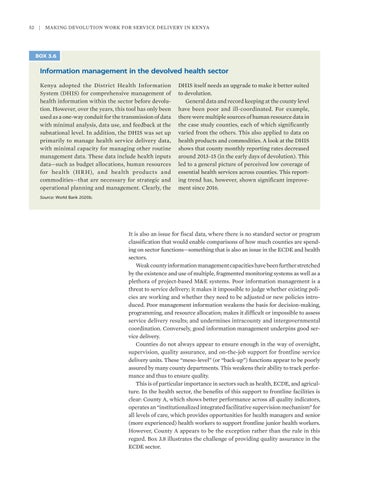52
|
Making Devolution Work for Service Delivery in Kenya
BOX 3.6
Information management in the devolved health sector Kenya adopted the District Health Information System (DHIS) for comprehensive management of health information within the sector before devolution. However, over the years, this tool has only been used as a one-way conduit for the transmission of data with minimal analysis, data use, and feedback at the subnational level. In addition, the DHIS was set up primarily to manage health service delivery data, with minimal capacity for managing other routine management data. These data include health inputs data—such as budget allocations, human resources for health (HR H), and health products and commodities—that are necessary for strategic and operational planning and management. Clearly, the
DHIS itself needs an upgrade to make it better suited to devolution. General data and record keeping at the county level have been poor and ill-coordinated. For example, there were multiple sources of human resource data in the case study counties, each of which significantly varied from the others. This also applied to data on health products and commodities. A look at the DHIS shows that county monthly reporting rates decreased around 2013–15 (in the early days of devolution). This led to a general picture of perceived low coverage of essential health services across counties. This reporting trend has, however, shown significant improvement since 2016.
Source: World Bank 2020b.
It is also an issue for fiscal data, where there is no standard sector or program classification that would enable comparisons of how much counties are spending on sector functions—something that is also an issue in the ECDE and health sectors. Weak county information management capacities have been further stretched by the existence and use of multiple, fragmented monitoring systems as well as a plethora of project-based M&E systems. Poor information management is a threat to service delivery; it makes it impossible to judge whether existing policies are working and whether they need to be adjusted or new policies introduced. Poor management information weakens the basis for decision-making, programming, and resource allocation; makes it difficult or impossible to assess service delivery results; and undermines intracounty and intergovernmental coordination. Conversely, good information management underpins good service delivery. Counties do not always appear to ensure enough in the way of oversight, supervision, quality assurance, and on-the-job support for frontline service delivery units. These “meso-level” (or “back-up”) functions appear to be poorly assured by many county departments. This weakens their ability to track performance and thus to ensure quality. This is of particular importance in sectors such as health, ECDE, and agriculture. In the health sector, the benefits of this support to frontline facilities is clear: County A, which shows better performance across all quality indicators, operates an “institutionalized integrated facilitative supervision mechanism” for all levels of care, which provides opportunities for health managers and senior (more experienced) health workers to support frontline junior health workers. However, County A appears to be the exception rather than the rule in this regard. Box 3.8 illustrates the challenge of providing quality assurance in the ECDE sector.


